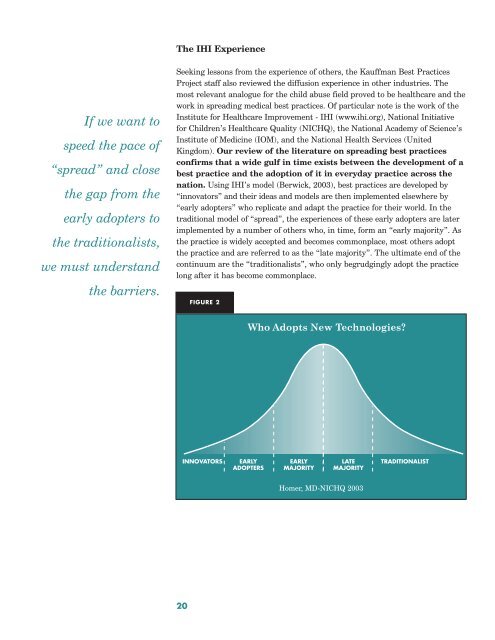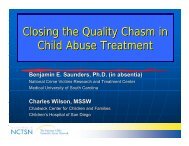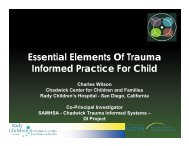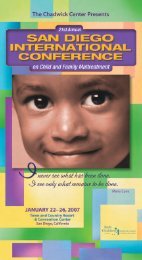Kauffman Best Practices Project Final Report - The Chadwick Center ...
Kauffman Best Practices Project Final Report - The Chadwick Center ...
Kauffman Best Practices Project Final Report - The Chadwick Center ...
You also want an ePaper? Increase the reach of your titles
YUMPU automatically turns print PDFs into web optimized ePapers that Google loves.
<strong>The</strong> IHI Experience<br />
If we want to<br />
speed the pace of<br />
“spread” and close<br />
the gap from the<br />
early adopters to<br />
the traditionalists,<br />
we must understand<br />
the barriers.<br />
Seeking lessons from the experience of others, the <strong>Kauffman</strong> <strong>Best</strong> <strong>Practices</strong><br />
<strong>Project</strong> staff also reviewed the diffusion experience in other industries. <strong>The</strong><br />
most relevant analogue for the child abuse field proved to be healthcare and the<br />
work in spreading medical best practices. Of particular note is the work of the<br />
Institute for Healthcare Improvement - IHI (www.ihi.org), National Initiative<br />
for Children’s Healthcare Quality (NICHQ), the National Academy of Science’s<br />
Institute of Medicine (IOM), and the National Health Services (United<br />
Kingdom). Our review of the literature on spreading best practices<br />
confirms that a wide gulf in time exists between the development of a<br />
best practice and the adoption of it in everyday practice across the<br />
nation. Using IHI’s model (Berwick, 2003), best practices are developed by<br />
“innovators” and their ideas and models are then implemented elsewhere by<br />
“early adopters” who replicate and adapt the practice for their world. In the<br />
traditional model of “spread”, the experiences of these early adopters are later<br />
implemented by a number of others who, in time, form an “early majority”. As<br />
the practice is widely accepted and becomes commonplace, most others adopt<br />
the practice and are referred to as the “late majority”. <strong>The</strong> ultimate end of the<br />
continuum are the “traditionalists”, who only begrudgingly adopt the practice<br />
long after it has become commonplace.<br />
FIGURE 2<br />
Homer, MD-NICHQ 2003<br />
20






